Journey down BR-319: The path towards the destruction of the Amazon rainforest
Traveling nearly 900 kilometers through one the best-preserved natural areas in Brazil reveals how deforestation is spreading. President Jair Bolsonaro would like to pave the road entirely, but at what environmental cost?
Journey down the BR-319: The path towards the destruction of the Amazon rainforest
At 7am, the sun is already high in the sky. A man gets out of a pickup truck at the gas station and approaches the first woman in sight, introducing himself as Carlinhos Raimundo de Auxiliadora and waving a bill worth 200 reales (€31). “Do you have a husband?” he asks, his breath giving off a waft of alcohol. He is looking for company after getting paid and to celebrate something big: “I’m so happy, I’ve finally bought a piece of land!” To anyone who warns him to watch the wad of notes he is brandishing, he replies with a laugh: “Me, I’ve got a .38 hanging from my belt.” His shirt is untucked, making it difficult to know whether the claim is true.
This is Realidade, the Brazilian Amazon’s promised land for hustlers and the poor. We have stopped at the first gas station to be found after driving 500 kilometers south on the BR-319, the most controversial road in the Amazon.
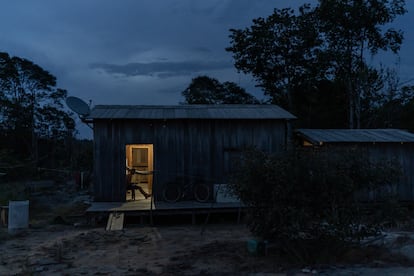
President Jair Bolsonaro has made a promise to pave the entirety of the road for this region, one of the poorest in Brazil, as he considers it strategic for local economic development. An EL PAÍS team traveled from the city of Manaus down to Porto Velho to observe the impact produced by settlers who flock to this area, drawn in by cheap land and promises of development. Meanwhile deforestation is advancing rapidly.
On a map, the road is just a small line. From the view of a drone, it is a straight orange line streaking through a thick green mass, like a head of broccoli. Probably few of those attending the COP26 climate summit in Glasgow were aware of its existence, but conservationists trying to save the world’s largest tropical rainforest keep a constant eye on it. Its future will tell whether the most pristine part of the Amazon can continue to protect biodiversity and capture carbon dioxide, or not. Rainforests like this one are crucial to regulating global temperatures on the planet.
The small town of Realidade is a succession of bars, motels, trucks, workshops, evangelical churches and little wooden houses on dirt roads that turn into a quagmire in the rain. In the last few years it has grown and now has its own school and health clinic, in a boom driven by the lucrative businesses that destroy the jungle: illegal logging, cattle ranching and soybean farming.
The law is a distant and flexible concept here, and suspicion prevails towards the curious outsider. After all, no one comes here by chance. Everyone has an agenda and is on constant alert, and there is no police presence for hundreds of kilometers. The locals have been anxiously awaiting the paved road for decades, convinced that it will bring prosperity. For scientists and environmentalists, that would be a nightmare scenario because the easier access could create many more “Realidades” further up the road.
The 887 kilometers of BR-319 slice through one of the best preserved areas of the Amazon, a rainforest that covers half of Brazil in an area the size of the European Union. For half the year, the road is a mud bath. Travelers pass by farms christened Big Hope, Rich Earth or God Provides.
Dona Mocinha is one of the biggest supporters of the paving plans. She runs a motel at kilometer 260 and at age 64 still has the energy to attend night school. It’s been decades since Dona Mocinha settled in Igapó Açu, a community of houses built on wooden stilts to avoid floods. “There was a time when from November to May no one passed through here at all,” she said.
With the road now more or less passable all year round, she sees more trucks and 4x4s going by. “They say that the paved road will have an impact [on the environment], but what impact? Look, I’m not a biologist, but the biggest impact was generated when it was built,” she said about the original project, undertaken in the 1970s by the dictatorship in power at the time. The task must have been monumental, because the terrain is swampy and rich in biodiversity. “It is criss-crossed by rivers full of fish, crocodiles and mosquitoes,” explained Rómulo Batista from the environmental group Greenpeace.
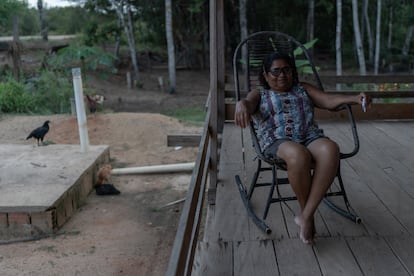
Mocinha, a member of the Association of Friends and Defenders of BR-319, knows that the improvements to the road will bring other, less desirable consequences. “When development comes along so does deforestation, burglaries, prostitution, drugs... but not having BR-319 would be worse,” she said from her rocking chair. People feel trapped in this beautiful but isolated corner of the country because it is the only land route from Manaus, capital of the state of Amazonas, to the heart of Brazil.
Mocinha has met many who are attracted by the area’s seemingly endless opportunities. “Many come from Rondônia or Mato Grosso. They are looking for land, land, land. I tell them no, I don’t have land to sell, this is a nature reserve! Look, I arrived 44 years ago and I have never sold a plot of land. And they have even threatened to kill me,” she revealed. Selling plots in protected areas is a crime, but huge tracts of public land flank the highway. Anyone can easily appropriate them with fake documents and the blind eye of local politicians. This land grabbing is known in Portuguese as grilagem.
The landscape offers a glimpse of the catastrophic scenario anticipated by scientists such as the tropical agronomist Jolemia Chagas, who has monitored the stretch of highway between kilometers 250 and 280. “Paving the road will intensify the appropriation of the last five years,” she warned. Real estate speculation, violent conflicts with the locals and environmental problems are just some of the consequences. “The removal of forest cover directly interferes with the production of ‘flying rivers’ or air currents carrying water vapor that supply part of South America, which will directly impact agriculture,” she added.
The area is populated by families who live largely from subsistence agriculture or selling produce, though there are 18 indigenous villages scattered far from the main road. One of the secondary dirt roads that is under construction is within touching distance of the territory where a group of around 30 isolated indigenous people live. They are probably descendants of the Juma people who survived a massacre in 1964, explained the anthropologist Pedro da Silva, of the Indigenous Missionary Council.
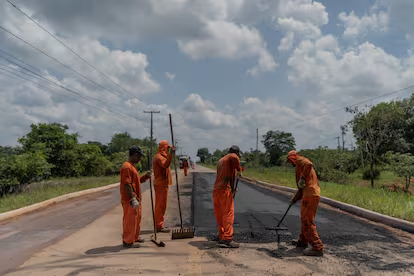
With the increase in traffic, restaurants, farms and churches have sprung up. Along the route there are trucks, cars carrying all the possessions of people pursuing a better future or seeking the business opportunity of a lifetime, whether legal or not; there are also bikers in their fifties on personal road trips. The journey starts in Manaos, where the lanes are carefully divided with yellow lines and the curbs are painted white. Soon later we come to the Amazon River, which can be crossed by raft. Though expensive and slow, travelling down the river is the most common form of transportation around here.
Kilometer 198 marks the end of the paved road and the beginning of the so-called middle stretch, which lost its concrete top at the end of the 1980s due to neglect. The impact of humans is much less marked than in other regions of the Brazilian Amazon thanks to this and to the environmental and indigenous reserves created since then.
Even visitors unfamiliar with the rainforest can tell when they are passing through a nature reserve. The trees and vegetation form such a dense green blanket that it is impossible to penetrate with the naked eye. From above, satellites photograph three-square-meter plots to measure where and how fast the rainforest is being destroyed. Deforestation was already on the rise before, but it has skyrocketed under Bolsonaro. Last year was the worst of the previous 12, when 11,000 square kilometers of trees disappeared. The Amazon lost the equivalent of three soccer fields every minute last year, according to Greenpeace.
Joeliton Silva, a 53-year-old fazendeiro (large-scale farmer), does not deny that deforestation is happening. For years he has cleared paths through the vegetation for visitors who then cut down the most valuable trees as part of a multimillion-dollar business. But he challenges journalists to tell what he calls “the truth”, a theory that hinges on the forest being so large that the destruction barely registers. Silva says that the effect of human action on temperature is “insignificant,” denying current scientific consensus. “At this rate it will take 140 years to deforest 10% of Brazil,” he says. Silva repeats this idea in YouTube videos he uploads from his home outside Realidade.
He is convinced that the international alarm about the disappearance of the Amazon’s unique flora and fauna is excessive, and nothing more than an excuse to camouflage the greed of foreigners who want to take away Brazil’s natural wealth. He is the owner of two large estates totaling 6,400 hectares, but one is up for sale because his foray into fish farming has not taken off.
Contributing to illegal deforestation does not keep Silva awake at night because doing it legally is impossible, he counters. He has tried. It’s better business, he adds, to do it the hard way and if you get caught, to appeal the fines. A Bolsonaro fan, he proudly plays a video showing him hugging the current minister of infrastructure while the latter declares that a paved BR-319 is on its way.
Many agree with Bolsonaro’s claim that environmental protection hinders development, which then opens the door to exploitation, easy profits and impunity. Brazil is fighting its image as an environmental villain, but the perverse idea that other countries deforested to develop, and so must Brazil, has legs, said Fernanda Meirelles of the BR-319 Observatory, an alliance of NGOs that monitors the road from Manaus. “We are not against the road, but first we want to solve the problems of land ownership, oversight, and how the nature reserves are managed,” she explained. After a long explanation of the innumerable challenges that lie ahead, she added: “My dream would be an elevated walkway.”
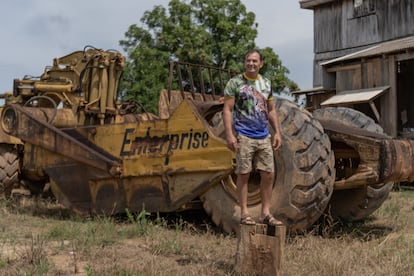
Back in Realidade, Dona Mocinha participated in recent public hearings that offer the best proof that the bureaucratic process is moving forward. The Bolsonaro government has given more impetus to the project than any of its predecessors. It remains to be seen whether or not IBAMA, the government agency that manages environmental policy, will authorize the paving of the road. None of those consulted believes it will reject it, but the NGOs underscore that indigenous people should have already been consulted.
Often, a truck stuck in the mud cuts off traffic, even at the end of the dry season. Truck driver Aulcides Costa, 49, was trapped for eight days. “After five days we ran out of food and mineral water,” he recalled. People in these areas lived cut off from the world until the internet arrived, turning them into a community and entertaining them during the long rainy season. Now the state of the road is documented in real time thanks to the 46 WhatsApp groups of the Association of Friends of the BR-319, with a total of 10,000 members.
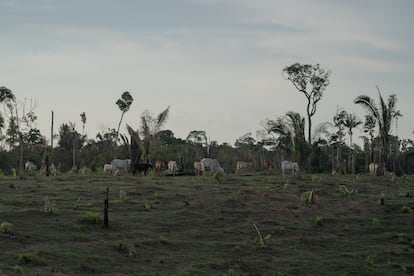
As one moves south, clearings start to appear on the hard shoulder. Suddenly, cows can be seen grazing on the sides of the road. The bucolic scene disguises its damaging effects on the Amazon. The cattle and the felling of trees to create grazing pastures are the main sources of Brazil’s greenhouse gas emissions. These increased even in the first year of the pandemic while they plummeted in the rest of the world as global commerce came to a standstill. After the logging, the pastures are used for feeding, and then come the soybean crops.
The businessman Antonio Graças, 71, is convinced that it is now or never. In his warehouse in Careiro de Castanho, surrounded by beds, household appliances and fans, he believes that the president and his minister of infrastructure, both of whom have links to the military, will take up the mantle of a project promoted by Brazil’s dictatorship half a century ago. These military men cleared the jungle to build roads and gave away land. In the midst of the Cold War, the obsession was to populate an area inhabited for millennia by indigenous people, to ensure that no one could take it away from the new settlers.

Graças fervently hopes that Bolsonaro won’t let the occasion pass him by. “If he doesn’t give the initial impetus for one company to [pave] 100 kilometers, and another the next 100... it’s not going to happen. Then, only God will tell.” The businessman dismisses any risk of an increase in environmental crimes because that is what the state is for, he says. On paper his long list of institutions with supervisory powers could stop exploitation, but in practice it’s a different story.
Towards the end of BR-319, at the point where it crosses the famous Trans-Amazonian Highway, one arrives at Humaitá. A mob set fire to the state environmental agency’s headquarters in the city in 2017. Vegetation already covers the ruins of the building. The country’s vice president, General Hamilton Mourão, freely admits that the risk of deforestation will increase with the paved road, and maintains that surveillance will have to be reinforced. But he says it will also facilitate the eventual arrival of the Federal Police to this remote area.
Credits
More information
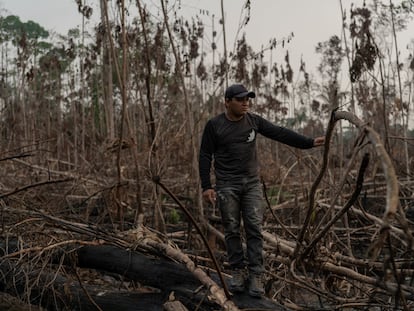
The Amazon rainforest under Bolsonaro: a story of fire and violence in Brazil
